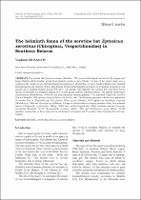The helminth fauna of the serotine bat Epte-sicus serotinus (Chiroptera, Vespertilionidae) in Southern Belarus
Abstract
The serotine bat Eptesicus serotinus (Schreber, 1774) as one of chiropteran species can fly, migrate and, being infected with helminths, spread these parasitic worms in their habitat. The aim of the current study was to summarize the results of own helminthological investigation of serotine bats living in Southern Belarus also establish helminth species and infection of these chiropterans. The helminthological examination of 28 serotine bat carcasses was carried out in Southern Belarus during 1996–2015. All animals were infected. The serotine bats were hosts for 12 species of helminths: six trematode species, two cestode species and four nematode species. The cestode Vampirolepis skrjabinariana (Skarbilovich, 1946) was the most frequently detected parasites. The trematode Plagiorchis muelleri Tkach et Sharpilo, 1990 has been found in Belarus for the first time. This helminth registered in Belorussian population of serotine bats as Plagiorchis sp. The cestode Milina grisea Beneden, 1873 appears as Myotolepis crimensis (Skarbilovich, 1946) and Myotolepis sp. in Belarus. All species of helminths are ordinary parasites of bats. One helminth species ((Plagiorchis vespertilionis (Müller, 1780)) have medical significance. Three nematode species ((Ascarops strongylina (Rudolphi, 1819), Physocephalus sexalatus (Molin, 1860) and Physaloptera myotis (Babos, 1954)) parasitize serotine bats on larval stage and two of them (A. strongylina and P. sexalatus) have important for veterinary science.
